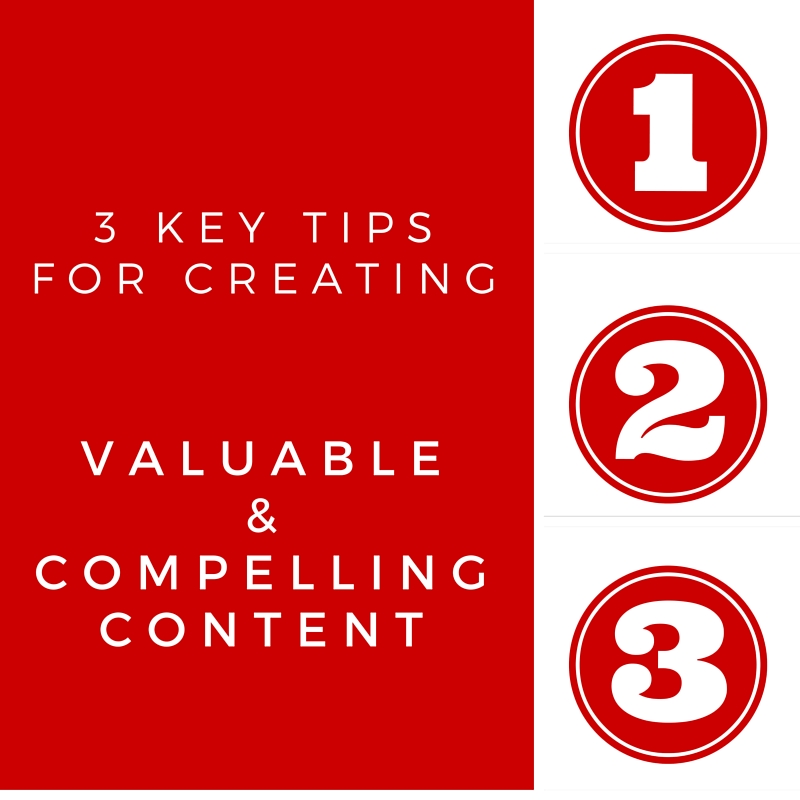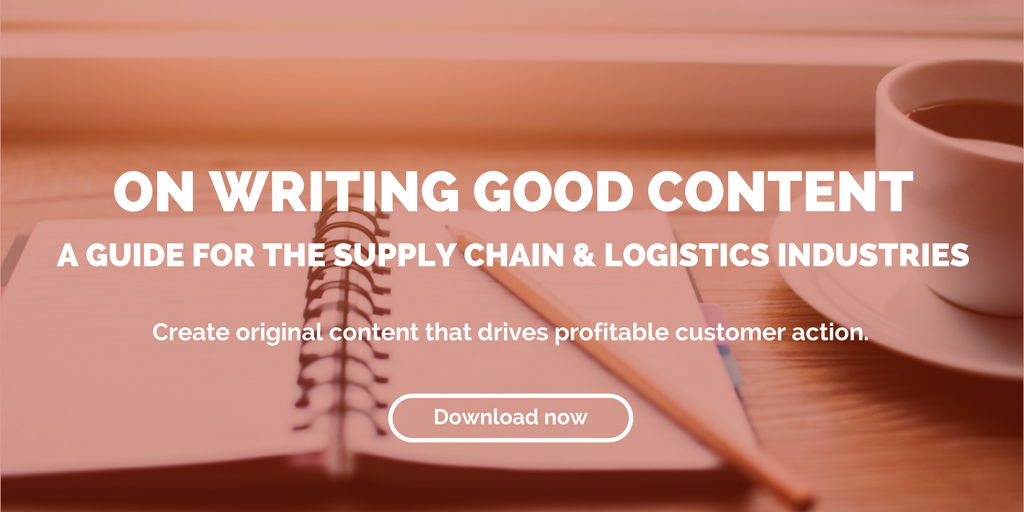
by Jennifer Hart Yim | Mar 23, 2016 | Blog, Content Marketing, Marketing

Editor’s note: This is a guest post by Jennifer Cortez, Director, Marketing Communications, Transplace. Transplace is a North American non-asset-based provider offering manufacturers, retailers, chemical and consumer packaged goods companies the optimal blend of logistics technology and transportation management services.
Content has become a critical component of the modern marketing mix, but companies have to walk a fine line when it comes to the information that is being pushed out to the market. Too little and your audience will become bored and uninterested, and unfortunately, may look elsewhere for information (i.e., your competition). Too much and your audience may not know where to start (especially if it’s poorly organized). And if churning out too much content leads to a decline in quality, your audience may be left with dull, unremarkable content that, most importantly, is lacking in value to the industry.
When we’re creating content here at Transplace, (and I encourage others to keep this in mind) we ask ourselves this question: “Why should my customer care?” If you can’t answer that question, then it’s time to rethink your strategy. If you’re creating content just for the sake of it or because it’s something you know you need to do, you are most likely headed down the wrong path.
If you’re new to content marketing, first figure out what you want your content to solve before getting started. Do you want to increase brand awareness or drive more traffic to your website? Or maybe you’re focused on converting more leads into customers? Whatever it might be, each of your marketing goals will influence your content marketing strategy and therefore help you understand the audience you’re writing for, what channels you’ll share the content on, and how you’ll communicate key messages.
3 Key Content Considerations
Content is an extremely important part of our marketing and communications strategy and helps us continue to grow our brand awareness and thought leadership in the logistics and transportation industry. Our main objectives focus on three things: creating quality content that is relevant and helpful to the people in our industry, easy to understand and comes in a variety of formats. Let’s dig into these three areas a little further.
1. Producing helpful content
It’s easy to produce self-serving content such as sales pitches or a 1-pager on ‘Why you should pick our company,’ but let’s face it – tooting your own horn isn’t going to do much in terms of moving the needle closer to any of those marketing goals we mentioned previously. And most likely, these types of content pieces aren’t going to be searched for or probably even read by your target audience. One of two things occurs with standard sales slicks these days – they get deleted or physically thrown in the trash.
What is going to be helpful is producing content that becomes a useful resource for people in their day-to-day job. We want to keep them updated on trends, but it’s also important for us to keep in mind what we should be talking about that others aren’t. What are we foreseeing based on our unique position in the market that we can relay through content so our network is more prepared? If we can do a better job of talking to the buyer and figuring out what they want to hear about, then our content is only going to prove that much more valuable.
2. Content readability is key
Sometimes the topics in our industry can be complicated and it’s our job as the subject matter experts to make these complex topics understandable. It’s also important to not talk above your audience. You’ve probably heard of the Flesch readability score before, which indicates how difficult a reading passage is to understand. Content readability is powerful and your content marketing, website and SEO are dependent on it. Search engines like Bing and Google prefer readable content so when it comes to writing – keep it readable, compelling and easy to understand.
3. Content variety keeps things fresh
What I mean by this is have some fun with the types of content being created or reused for additional purposes. Did you conduct a survey and now have some great data points to share? Instead of housing this valuable information in a long article or whitepaper, you could highlight the research in an animated infographic. At Transplace, we’ve had great success at creating a variety of content pieces – from videos and podcasts to our TIP List and Q&As – we change up the types of content we’re creating to keep our audience coming back for more. You can also leverage existing content to create “new” types of thought leadership to push out. Nowadays there are several different ways people prefer to digest news and information, and we don’t have a crystal ball to show us these preferences, so you do typically need content in multiple forms in several different places whether that be print, online or social media. The permutations of content creation are endless if you tap into your creativity and keep things fresh!
Today, there is so much content out there that it’s become all too important for companies to truly create value in the information that they’re pushing out to the market. And when it comes to valuable content, keeping these three tips in mind will have you well on your way to creating content that is helpful to your audience and keeps them coming back for more!


by Fronetics | Mar 7, 2016 | Blog, Content Marketing, Marketing, Social Media

Your content stinks. Here’s why.
Twenty-seven million pieces of content are shared every day — and most of it is crap. To attract readers to your content, you must stand out, and I mean really stand out, among the masses. That’s no easy feat.
You may be spending an enormous amount of time and money as part of a content marketing effort, but, if no one is reading what you’re producing, you’re definitely not achieving your ROI. Consider the following points, and ask yourself if any could be negatively impacting your readership.
Here are the top 10 reasons no one is reading your content.
10. You don’t have a strategy.
Only 11% of companies without a documented content marketing strategy find their efforts to be successful, compared to 60% of companies with a strategy in place. And that number rises to 86% when the company designates someone to lead the strategy. Having a clear vision for your content and a plan for executing that vision is crucial to earning an audience.
9. Your content isn’t search-engine optimized.
Seventy-seven percent of today’s buyers use Google to research information about products. Search engine optimization (SEO) means writing copy for your digital assets so they will be prioritized by Google in web queries related to your business or products. Three of four people will click on the top five search results. So the further you move from those top five results, the less likely someone is to find, much less read, your content. If your content isn’t SEO-friendly, readers may not even have the chance to see what you’re writing because it is so far down in their search results.
8. You are using the wrong channels.
If a tree falls in the woods and nobody is around to hear it, did the tree fall after all? Stop publishing in the empty woods. Who is the target audience for your content, and where are they active? Evaluate your audience (or lack thereof) in each of the channels where you publish, and see if something is amiss. This will vary greatly by business. You can access personalized information on your followers’ social media habits through analytic programs like Google Analytics and sites like Tweriod.
Also to consider: on lightning-fast platforms like Twitter, a miscalculation of timing could be to blame. (See The Best Time to Post on Social Media.)
7. You’re not publishing often enough.
Inconsistent content is one of the primary reasons readers become disengaged with a particular publisher. Even publishing one more blog post a week can significantly boost your readership. Try a little experiment for a few months by playing with the number of times per week you publish — say, three times per week one month, four times the next, and five the next. You’ll find the sweet spot where you get the most engagement but can also handle the production schedule.
The next reasons have to do with the substance of the content itself.
6. You’re publishing a sales pitch instead of content.
Imagine you’re looking to buy a car. Researching different options online, Site A, run by Dealership A, offers expert opinions about various makes and models, while Site B talks about how Dealership B offers top-notch customer service and a no-nonsense negotiation policy. You’d probably never come across Site B in the first place because the content is irrelevant (and trite… and annoying), whereas Site A has exactly what you’re looking for.
Content marketing is your opportunity to provide valuable, expert information to people who are seeking it out. Associating your brand with that sort of expertise attracts customers — not to mention, helps them find you via organic search in the first place. No one wants to read your sales pitch over and over again, and they won’t.
5. You are not telling the truth.
I am talking about two different definitions of truth here.
For one, are you being honest? Today’s consumers can smell b.s. from a mile away, largely because the Internet forgets nothing and forgives nothing. The prevalence of user-review sites and platforms like social media means customers will always have an outlet to share their experiences, both good and bad. If your business does not provide what you promise, people will be upset and take to these forums to complain about it. Trust and transparency are two key assets in earning (and keeping) readership.
Secondly, are you being true to who you are as a business? A recent Harvard Business Review article defines successful marketers as mission-focused, not consumer-focused. Don’t produce content based on what you think your customers want to hear. The beauty of content marketing is that when you put your business mission out into the universe through content, people who are seeking that information find you. In other words, build it, and they will come.
4. You’re not offering anything of value.
DigitalTonto says, “The first step towards engagement is creating value beyond the basic transaction of payment for a product or service.” This is the essence of content marketing: a related offer of value in the form of expertise, entertainment, etc. For example, L’Oreal Paris provides free makeup tutorials on its YouTube channel, Destination Beauty, and, Apple offers free classes, product demonstrations, and tech support from the Genius Bar for product users.
The question to ask is, what is your value to your customers? Can you offer expert advice on a particular topic through a blog? Is there something about your products or your people that would make for entertaining or informative videos? Do you have access to top-of-their-field specialists that could lead a webinar series? Find whatever it is that is unique to your company, and leverage that in your content marketing to attract readers.
Because there is so much content out there, today’s consumers can afford to be partial to publishers who provide information in a way that is pleasing to them. They also have shorter attention spans than goldfish. That means things like format, length, accessibility, and voice can majorly impact whether people read your content or not. Also, be mindful that different platforms should offer different experiences based on reader expectations (e.g., Instagram isn’t the place for lots of text).
2. You’re not heeding performance analytics.
The one certain constant in marketing is that things will always change. What works for you one year will certainly be irrelevant the next. Content marketing won’t allow you to rest on your laurels, either. You should stay on top of your analytics to monitor what kind of content is successful in the present moment, and you should tweak how you’re doing things as people, technology, and events change. Keep testing new ideas to see how they are received, and get rid of old standbys that no longer pull their weight.
1. Your content is bad.
While this seems obvious, it’s worth repeating. If the quality of your content is bad, no one will read it, regardless of what value it offers. The same goes for if you find yourself saying, “it works,” or “it’s fine!” If there are 27 million options, who would choose “fine?”
Do an honest evaluation of your content, or have a neutral outside party do so for you. Is it original, substantial, and well-written? Make sure that your content is edited, and that it is free from grammatical errors, spelling mistakes, and awkward phrasing. And remember that you get what you pay for. Professional writers can be expensive, but there’s a reason for that — theirs is a specialized craft, and very few people can do it well. If you want people to read your content, you should make sure that it’s worth reading.
Related articles:

by Fronetics | Feb 25, 2016 | Blog, Content Marketing, Data/Analytics, Marketing, Strategy
https://www.flickr.com/photos/132604339@N03/22920388895/in/photostream/
The most efficient lead-generation strategy includes a way to capture potential customers’ information.
An effective lead-generation campaign requires several different strategic layers.
Firstly, you must entice potential customers with an exclusive, high-value offer — like ebooks, whitepapers, free consultations, product demonstrations, or discounts. A clear, highly visible call to action (CTA) or two can help ensure they know how to attain it and can encourage them to choose it over your competitors’ offers.
But you’re not done there. Unless you are capturing those quality leads effectively, you could be dropping the ball and missing out on potential customers.
Here are some tips for successfully capturing leads.
You absolutely need to have a landing page for your offer. Your CTA should not take the potential customer to your website’s homepage or anywhere else, but rather to a landing page, which provides your offer and captures the lead information.
Landing pages are one of the most important elements of lead generation and are effective for 94% of B2B and B2C companies, according to research done by MarketingSherpa. A great landing page:
- Describes the offer
- Does not include links to other things on your website that will distract the lead and perhaps send them elsewhere before you can obtain their information
- Is simple and not cluttered with information but emphasizes the benefits of your offer
- Has ways to share the offer on social media
- Has a form to capture the lead information
Capturing leads: It’s all in your form
The last point suggests the next step in your strategy: A good form is how you will successfully capture those leads. It is where your potential customers will provide their contact information in exchange for the special offer you have enticed them with.
So, what makes for a good form?
- Keep it short. The fewer fields you have in a form, the more likely you will receive conversions.
- Avoid using the word “submit” on your form. Nobody wants to submit their information, so use a phrase that demonstrates that they are getting something they want by supplying their information — something simple like “Get it free,” or “Download now.”
- Add a privacy message (or link to your privacy policy) that indicates their email or contact information will not be shared or sold.
Want more leads? Use multiple channels
To generate and capture the most leads possible, completing these steps in just one of your marketing platforms is not enough. Marketers should utilize multiple channels in order to maximize their lead-generation efforts.
The objective is to make it easy for buyers to research, evaluate, and purchase products in any way that is most appropriate for them. Some leads may find you through your blog, some through social media, and some through organic search (which is why all of your content should be SEO-friendly). Thus, you should make sure you are promoting your special offers, effectively placing CTAs, and properly using landing pages and forms in every facet of your digital presence.
Such an efficient, multi-layer lead-generation strategy can reduce your cost per lead while delivering higher quality prospects to your sales team.
Want to learn more? Download for a complete list of innovative tips and proven strategies to improve your lead-generation and -nurturing strategy.
Download guide
Related posts:

by Fronetics | Feb 3, 2016 | Blog, Content Marketing, Marketing, Social Media

A blog post not only stays around longer than a print ad, it can better engage potential customers.
The 24-hour news cycle has evolved into the 24-second news cycle with the rise of online media outlets and social media. So, when it comes to advertising your business, generating leads, making sales, and being perceived as a thought leader, you must consider the lifespan of your print ad and its purpose, versus the lifespan of a well-orchestrated blog and its potential.
Though often confused, there is a distinct difference between advertising and marketing. With a print ad, you are obviously advertising your business concisely, with a limited number of words and images. But, this form of advertising has a limited lifespan (only as long as that piece of print media is in the hands of a reader). So, it should be only one small piece of your marketing puzzle.
In contrast, a blog bridges advertising with progressive marketing techniques. It reaches your target demographic in a different way by conveying knowledge and building trust. It works on improving your “image” as well as branding your company as a thought-leader. A blog makes a more personal connection with the reader, while an ad is very obviously trying to sell something — and consumers gravitate toward knowledge rather than a simple sales pitch.
Looking at Longevity
A blog can live on indefinitely. What you post today may still be relevant and a popular read several months from now. Because of this, your company can reach a larger number of consumers within its target demographic for a long period of time, surpassing a print ad’s capacity for results. A blog also reaches consumers in a more relevant, memorable way. Marketing experts would agree: Getting your clients or customers to remember you is half the battle.
Your company’s advertising can include the placement of an ad in print media like newspapers, magazines, or direct mail. Print ads through community newspapers or direct mail flyers are useful for specific purposes, like targeting customers in a localized area.
But, you will find that advertising of this kind comes with a sizable price tag and has limited benefits. According to a Marketing Profs digital report, print advertising ranks as the largest expense of most marketing plans, with public relations and marketing strategies rounding out the important trio.
So how long will a print ad live? According to a marketing study published by Fast Company, a newspaper ad has a maximum lifespan of 2-3 weeks, and an ad placed in a monthly magazine may live up to three months.
In contrast, when a blog post goes live, it may generate the most hits within the first week, but it will continue to serve as available content that consumers will access for months, or even years, down the road. If the blog is well constructed, you may find that a year later it is still ranking in the top five search results for certain targeted long-tailed keywords.
So, it is important to consider the “quality of life” of your blogs and print ads. A blog feeds consumers’ need for more information before they commit. In fact, prior to contracting your services or buying your product, your potential customers will research the topic online and read blogs posts that present information in a vendor-neutral format.
Successful businesses react to this by creating a constant stream of this fresh content, organized into a library of posts (that stand the test of time), then use that content as bait to attract potential prospects. One study revealed that when it comes to blogs, the combination of proper timing and useful insight can result in a 33% higher lead conversion rate and a 38% increase in revenue over the prior year.
Blogs’ Benefits and Social Media
When you publish a print ad, you’ll never really know what your readers think about it. With a blog, you get feedback and you engage the reader, who is also a potential customer. It creates a more viable connection and provides greater insight that you can leverage to garner more customers through:
- Tracking and analytics: Feedback is a powerful tool. Google Analytics can tell you what types of articles are capturing your readers’ attention. You can learn how much time they spend on a page and how they share it. You can leverage this information to determine what sort of content you need to create to reach more customers and generate more leads.
- Shares and comments: Readers love to interact with online content, reading and commenting to express their opinion or thoughts. The comment section of your blog can become a community of readers. If a reader found your blog insightful or inspiring, they may also share it with their contacts or friends through social media. Your business becomes a part of a larger community that is connected through dialogue.
Advertising in any form, digital or print, is only a single component of any complete, multi-level marketing process. Innovative marketing today must include several different components, like well-articulated blog posts that utilize SEO, and connect potential customers to your company by offering information they can use. Blogs are a long-lasting porthole to your business, the product or the services you offer, and your professional insight or vision.
Related articles:

by Fronetics | Jan 18, 2016 | Blog, Content Marketing, Marketing, Strategy
Improve your content marketing strategy in 2016 by following these six tips.
We know that content marketing is a highly effective tool for companies of all shapes and sizes, be they B2C or B2B. (If you’re not using inbound marketing, here are five reasons why you should be.) But, considering this strategy takes considerable time, effort, and resources, are you getting the most out of your efforts?
Long gone are the days when a weekly blog and vague presence on social media will cut it — 2016 is calling for a diversified content marketing strategy that speaks to today’s sophisticated consumer base.
Here are 6 ways to improve your content marketing strategy in 2016:
1) Be mobile-friendly.
Google announced in May 2015 that the number of searches on mobile devices has now surpassed those conducted on desktops in the US. And we know that reality isn’t limited to personal Internet use. Evidence suggests B2B buyers are increasingly using mobile devices to do research, make inquiries, and purchase products. If your website isn’t mobile-friendly, your company is missing out the significant share of customers who demand mobile-optimized content. What’s more, Google now penalizes non-mobile sites in searches, meaning your website will fall further below the fold, as more companies cater to smartphone screens.
Here’s how to make your supply chain website mobile-friendly.
2) Diversify your content.
A blog for which you provide regular, original content is an excellent start . But, unfortunately in this day and age, it’s not enough. Offering content in different formats provides a richer experience for your leads, adds depth to your brand identity, and allows you to reach and connect with more consumers. There are a dizzying number of options out there, including podcasts, slideshares, videos, graphics, ebooks, and whitepapers, to name a few. Choose a couple that fit your brand best, and see where they take you. Which leads me to…
3) Do video.
Video is not just for funny cats and cover artists anymore — it’s the most popular form of content being consumed online. YouTube is the second largest search engine in the world, with more than one billion users conducting over 3 billion searches per month. What’s more, the number of videos uploaded to Facebook has increased by 94% over the last year, with more than 50% of Americans who use Facebook daily viewing at least one video per day. Some brands have capitalized on this trend. (See the Budweiser puppy commercial, viewed over 30 million times.) But there is a lot of potential there for businesses in all industries — a little creativity and some time and effort adding video to your content marketing suite could really pay off.
4) Tug at the heartstrings.
There’s a reason the Budweiser puppy video has enjoyed so much success: we love a feel-good story. An ad that evokes strong emotions makes us associate those feelings with the brand. Studies show that emotions play a leading role in B2B purchases, too, and your content marketing should leverage that idea by telling great stories and by promoting the value you offer. Content that tells a great story connects people to your brand on an emotional and intellectual level, helping earn their trust and loyalty. Similarly, by touting figures that illustrate the value your company offers its customers — like money saved, convenience, or top-of-the-line performance — you remind people what it is you can do for them. And there’s no better way to win hearts (and leads) than reminding them what they’ll get out of your relationship.
5) Focus on relationship marketing.
HubSpot identifies relationship marketing as the #1 game-changing marketing trend to tackle in 2016. While this term largely falls under the CRM umbrella, it can play an important role in your content marketing strategy as well. Providing existing customers with custom-tailored content and information shows that you understand their needs, and it makes communications infinitely more personal. You’re not just blasting out some mass communication that ignores the facts that you know about your client — for example, a mass email titled “Baby it’s cold outside!” to a client based in Florida. Modern technologies like geo-targeting and CRM software make personalizing content and communications much easier, but it will still take extra time and resources. That’s the (absolutely worth-it) cost of long-term, loyal customers earned through relationship marketing.
6) Seek professional help.
Even if you’re part of the 58% of companies that handles content in-house, a little help from the experts will only improve your results. Hiring an SEO-savvy copywriter, for instance, can impact your bottom line. Or working with a firm like Fronetics can help you develop and execute a content marketing strategy designed to grow brand awareness and to meet your specific business goals. Here are six other digital and content marketing tasks to outsource. A fresh perspective from outside your company may be just what your marketing efforts need to excel in 2016.
Related articles:
When it comes to marketing we work with our clients to create and execute strategies that drive success and elevate their brand position within the industry. Unlike other firms, we align marketing programs with business objectives and, through a data driven approach, are able to deliver results with a targeted ROI. Our team is comprised of strategists, marketing professionals, writers, designers, and experts in social media. Together we leverage our experience to increase brand awareness, position our clients as thought leaders, drive meaningful engagement with prospects and customers, and help businesses grow. Learn more about what we do.







